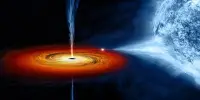An international team led by Stefan Pelletier, a student at the Université de Montréal’s Trottier Institute for Research on Exoplanets, studied the extremely hot giant exoplanet WASP-76 b in great detail.
The team was able to identify and measure the quantity of 11 chemical elements in the planet’s atmosphere using the MAROON-X instrument on the Gemini-North Telescope.
These include rock-forming elements whose abundances are unknown for the solar system big planets like Jupiter and Saturn. The research was published in the journal Nature.
“It is truly rare that an exoplanet hundreds of light years away can teach us something about our own solar system that would otherwise be impossible to learn,” Pelletier added. “This is the case with this particular study.”
A vast, hot, and bizarre planet: WASP-76 b is an odd planet. It reaches extraordinary temperatures because it is so close to its parent star, a giant star 634 light-years away in the constellation Pisces: about 12 times closer to the sun than Mercury is to the sun. It is relatively “puffy,” with a mass similar to Jupiter but about six times larger in volume.

Many teams have researched it and found numerous elements in its atmosphere since its discovery by the Wide Angle Search for Planets (WASP) program in 2013. Notably, in a study published in Nature in March 2020, a team discovered an iron signal and predicted that the planet would experience iron rain.
Pelletier was motivated after learning about these studies to collect new, independent observations of WASP-76 b using the MAROON-X high-resolution optical spectrograph on the Gemini-North 8-meter Telescope in Hawai’i, which is part of the International Gemini Observatory and is operated by NSF’s NOIRLab.
“We recognized that the powerful new MAROON-X spectrograph would enable us to study the chemical composition of WASP-76 b with a level of detail unprecedented for any giant planet,” explains co-author and Stefan Pelletier’s research supervisor, UdeM astronomy professor Björn Benneke.
A composition similar to that of the sun: The abundances of practically all elements in the periodic table are known with remarkable precision within the sun. However, just a few elements are true in our solar system’s large planets, whose compositions remain loosely limited. As a result, knowledge of the mechanisms regulating the development of these planets has been impeded.
WASP-76 b has a temperature far above 2,000°C due to its proximity to its star. Many elements that would typically form rocks on Earth (such as magnesium and iron) are evaporated and exist in gaseous form in the upper atmosphere at these temperatures.
The study of this unique planet provides unprecedented insight into the presence and abundance of rock-forming components in big planets, as these elements are lower in the atmosphere and thus impossible to detect in colder giant planets like Jupiter.
Many elements measured by Pelletier and his team in the exoplanet’s atmosphere, including manganese, chromium, magnesium, vanadium, barium, and calcium, closely match those of its host star as well as our own sun.
These abundances are not coincidental: they are the direct result of the Big Bang, followed by billions of years of stellar nucleosynthesis, so astronomers can measure nearly the same composition in all stars. It differs from the makeup of rocky planets like Earth, which are produced in a more complex way.
The findings of this new study suggest that large planets may retain an overall composition similar to that of the protoplanetary disk from which they arose.
The depletion of other elements is very intriguing: Other elements, however, were depleted on the planet when compared to the star, which Pelletier found particularly intriguing.
“These elements that appear to be missing from WASP-76 b’s atmosphere are precisely those that require higher temperatures to vaporize, like titanium and aluminum,” he explained. “Meanwhile, the ones that matched our predictions, like manganese, vanadium, or calcium, all vaporize at slightly lower temperatures.”
According to the discovery team, the observed composition of the upper atmospheres of big planets can be particularly sensitive to temperature. Depending on the temperature of condensation, an element will either be in gas form and present in the higher layers of the atmosphere, or it may condense into liquid form and sink to deeper layers. When in the gas state, it absorbs a lot of light and can be seen in astronomers’ views. When it is condensed, astronomers cannot detect it and it is completely absent from their observations.
“If confirmed, this finding would imply that two giant exoplanets with slightly different temperatures could have very different atmospheres,” Pelletier added. “Kind of like two pots of water, one frozen at -1°C and the other liquid at +1°C.” Calcium, for example, has been observed on WASP-76 b, but it may not be present on a slightly colder planet.”
Vanadium oxide was discovered for the first time: Another intriguing discovery made by Pelletier’s team is the discovery of a chemical known as vanadium oxide. This is the first time it has been unequivocally identified on an exoplanet, and astronomers are quite interested in it since they know it may have a significant impact on hot giant planets.
“This molecule plays a similar role to ozone in the Earth’s atmosphere: it is extremely efficient at heating up the upper atmosphere,” Pelletier explained. “This causes temperatures to rise as a function of altitude, rather than fall, as is typical on colder planets.”
One metal, nickel, is clearly more abundant than the scientists expected in the exoplanet’s atmosphere. Many possibilities could account for this, one of which is that WASP-76 b accreted material from a planet comparable to Mercury. Because of the way it evolved in our solar system, the small rocky planet is abundant with metals such as nickel.
Pelletier’s team also discovered that the previously documented asymmetry in iron absorption between the east and west hemispheres of WASP-76 b is also evident for several other elements. This implies that the underlying phenomenon producing this is most likely a global process, such as a temperature difference or clouds being present on one side of the planet but not the other, rather than the result of condensation into liquid form, as previously proposed.
Confirming and capitalizing on lessons learned: Pelletier and his colleagues are eager to learn more about this exoplanet and other ultra-hot giant planets, in part to prove their theory about the dramatically diverse atmospheres that could exist on planets with slightly different temperatures.
They also expect that other researchers will use what they’ve learned from this massive exoplanet to improve our understanding of our own solar system’s planets and how they formed.
“Generations of researchers have used Jupiter, Saturn, Uranus, and Neptune’s measured abundances of hydrogen and helium to benchmark formation theories of gaseous planets,” Bennet explained. “Measurements of heavier elements such as calcium or magnesium on WASP-76 b will also contribute to a better understanding of the formation of gaseous planets.”
“Vanadium oxide and a sharp onset of cold-trapping on a giant exoplanet,” published in Nature on June 14, 2023.















